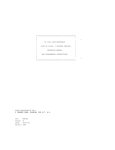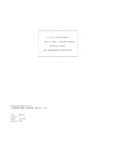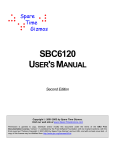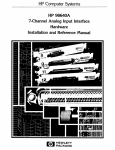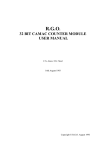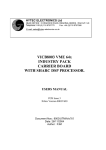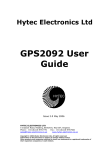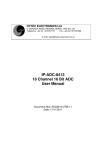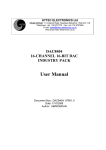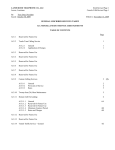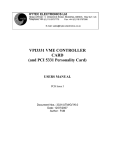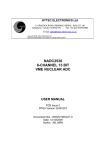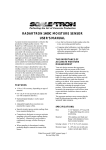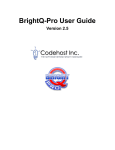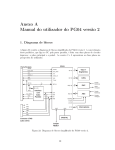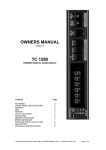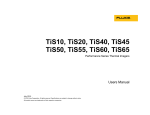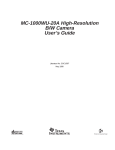Download User Manual - Hytec Electronics Ltd
Transcript
***************************************** * * * HYTEC ELECTRONICS LTD. * * * * SCA 1270 SYSTEM CRATE ADAPTOR * * * * MODULE SPECIFICATION * * * * AND TECHNICAL MANUAL * * * ***************************************** HYTEC ELECTRONICS LTD. 5 CRADOCK ROAD, READING, RG2 0JT, U.K. Doc: Issue: Date: Author: UM1270 4.0 09/01/2002 PJM Doc: Issue: Date: Page: Author: CONTENTS 1. Introduction 2. Principles of Operation Figure 1: Example System Configuration 3. CAMAC Command Set 4. Physical 5. Circuit Description 5.1 Data Buffers and Register 5.2 Command Register and Output Drivers 5.3 CAMAC Command Decode PAL and Control PAL 5.4 Priority Arbitration Circuitry 5.5 Reset and Booking Circuit 5.6 Status Register 5.7 Control Register 6. Parts List 7. Circuit Diagram - HL1031 UM1270 4.0 09/01/2002 1 PJM Doc: Issue: Date: Page: Author: 1. UM1270 4.0 09/01/2002 2 PJM Introduction There have always been lengthy discussions within Hytec Electronics Ltd. whenever a new Controller is being designed as to whether it should be Hytec System Crate or ACB (Auxiliary Control Bus) compatible. When the 1330 IBM PC Interface was conceived, its principal application was thought to be in Single Crate Dedicated Systems, so to avoid extra cost and complexity it was decided to make it an ACB device (either Master or Auxiliary). When the 1340 List Processor was being developed, since its concept originated in the USA, it too was made an ACB Auxiliary Controller. Both devices are therefore fundamentally unable to access multi-crate systems based on the Hytec System Crate method of realising Multi-Master Multi-Crate Architectures. Consider now the position of an Engineer wishing to add either device to a multi-crate system based on the Hytec System Crate. He must either put one of these devices into each of the Branch crates he wishes to monitor or control as an Auxiliary to the CCA2, or find some way of allowing his Controller to generate Branch cycles from the System Crate. This is what the System Crate Adaptor is designed to do. 2. Principles of Operation At the outset, since the ACB device will reside in the Hytec System Crate, the Executive Controller in that crate will have to be an MXCTR5 in order to allow the new Controller access to the crate. (The MXCTR5 is a System Crate Executive Controller with ACB Master capability). Looking at Figure 1, we see that our Auxiliary Controller will now be able to talk to modules in the System Crate, while the Computer Interface Program Source(s) can talk to the Branch Crates and modules in the System Crate. Doc: Issue: Date: Page: Author: UM1270 4.0 09/01/2002 3 PJM The System Crate Adaptor is a System Crate Program Source which is addressed as a user module by the Auxiliary Controller (and anyone else for that matter) and told what to do in terms of the Command, a 24 bit word in the form BCFNA: B (branch), C (crate), F (function code), N (station number), A (subaddress); and the Write Data (if any). Having received the Command, it will then either wait for the Write Data or start straight away trying to gain access to the System Crate via the Priority Arbitration Highway. [For further information on the method of operation of the System Crate see publications "Hytec System Crate Philosophy" and "Configuring Hytec System Crate Controllers"]. Having achieved Mastership, it then does its cycle, storing the state of Q and X from that cycle and the Read Data (if any). If the cycle is aborted by the Executive Controller due to non-reception of S2, or if X is not received, then the SCA will generate a LAM, provided the LAM Enable bit is set in the Control and Status Register. Note that once the SCA has "decided" to do a cycle, it will not accept any commands except Read CSR - F(1) A(12); Reset - F(25) A(15) and Test Done - F(8) A(15). Having caused the SCA to perform a cycle, the Auxiliary Controller should issue the Test Done command until it gets Q=1, and then either read the CSR to see if Q and X were received in the cycle or fetch the Read Data, or neither. Clearly it does not have to do either, if the Command was a Write Operation or dataless, and the state of Q and X are therefore unimportant. Fetching Read Data is conditioned by Q, depending on whether the SCA got a Q response during the cycle in question. Bit 2 in the Status Register shows whether the SCA has "Done" the last cycle requested, and this can also be tested by a separate command as mentioned earlier. Note that since the SCA will be doing a System Crate cycle immediately after being given a Command, it is extremely unlikely that the Auxiliary Controller will be able to do an ACB cycle before the SCA has finished, so telling it to ask the question "have you finished?" of the SCA is a bit academic, but for safety's sake it is recommended. If the last Command involved writing, then writing another word of Data will cause the same command to be repeated with the new Write Data. If the last command was a Read, then one might wish that command to be repeated automatically, and this can be done by setting bit 6 in the Control and Status Register, which causes the same command to be repeated when the data has been read out by F(0) A(0). Doc: Issue: Date: Page: Author: UM1270 4.0 09/01/2002 4 PJM In Multi-user systems, we must have a means of "booking" the module, so that competing prospective users can tell if another computer is already using the SCA or not. This is done in the same way as in the List Processor LP1340, i.e. by a "Test Available" command and a "Reset" command. The Q response to the "Test" F(27) A(0) - indicates whether the unit is in use, (Q=1 means "Available") and if it was available, then it will now become Booked, and give Q=0 to all further tests until given a "Reset" command (F(25) A(15)). 3. Command Set F(0) A(0) Read DATA Register X=1, Q="Q recd." Note that the Q response is only valid if the last CAMAC Command done by the SCA was a Read. F(0) A(1) Read Command Register X=1, Q=1 F(1) A(12) Read Control and Status Register X=1, Q="Done" CSR Format: 8 7 6 5 4 3 2 1 | Q | LE | RPT | spare | NO S2 | BUSY | X / | | | | \ / | | | | | Q Response LAM Repeat Cycle Not X resp. of of last cyc. Enb. Cycle Failed Fin. last cycle F(8) A(15) Test "Done" X=1, Q="Done" F(16) A(0) Write DATA Register * X=1, Q="Done" F(16) A(1) Write Command Register * X=1, Q="Done" Command Register Format: 24 23 22 21 20 19 18 17 16 15 14 --- 10 9 -- 5 4 --- 1 ----------------\-----/--\-------/-\--------/\-------/\-------/ Z G CAR SR B C F N A -------------------------------------------------------------| | | | | | | \ Stock Register Mode (and Serial Crate Address SC16) | \ Crate Address Register Mode (and Serial Crate Address SC8) | GL Read Operation Branch Initialise (Generate CZ) F(17) A(12) Write Control & Status Register * X=1, Q="Done" F(25) A(15) Reset: Clear PA, reset "booked" & CSR. X=1 Q=0 F(27) A(0) Test Available, X=1, Q=1 means "available" - and "books" the SCA: Q=0 means "booked" NOTE : * Means that write commands are not accepted if not "Done" Doc: Issue: Date: Page: Author: 4. UM1270 4.0 09/01/2002 5 PJM Physical The unit is a single-width CAMAC module, with two four-way LEMO connectors on the rear panel, for the Priority Arbitration Highway cables. The 30 front-panel LED indicators show the following:BOOKED In use N ADDRESSED ) ACTIVE Doing a CAMAC cycle ) stretched to 20mSec NO S2 Cycle aborted Q Q response from last CAMAC Cycle X X " " " " " Z Z Cycle loaded B4-B1 3-bit Branch Code SR Stock Register Mode CAR Crate Address Register Mode C4-C1 3-bit Crate Address N16-N1 Station Number A8-A1 Subaddress F16-F1 Function Code G GL Read Cycle loaded 5. Circuit Description 5.1 Data Buffers and Register Referring to circuit diagram HL1031, at the top on the left we see the Write Line Buffers. These IC's 11, 12 and 13 buffer the Write lines onto the internal bi-directional tri-state data bus, so that Command and Write Data information can be written into their appropriate Registers. Further down on the left-hand side, we see IC's 1,2 and 3 which are bi-directional devices which connect the internal bi-directional data bus to the Dataway Read Lines. When the unit is being addressed as a "User" module, these buffers feed information from either the Command Data or Status Registers OUT onto the Read Lines. When the unit is functioning as a System Crate Program Source, i.e. it is performing a System Crate Cycle, these buffers either put Write Data onto the Read Lines so that the Executive Controller can transfer it to the Write Lines for writing into the addressed module, or they accept Read Data from the addressed module for storage in the Data Register, ICs 6, 7 and 8. Note that there is only one Data Register, used for both Reading and Writing, thus its contents will be either the last set of write data given to the SCA or the last set of read data collected by the SCA. The Data Register or Data Store itself is Clocked, or written into, by K5 (CAB, Clock A to B) and is Read Out by K4 (GBA, Gate B to A). K5 and K4 come from the Decoding and Control PALs, ICs 26 and 27. Doc: Issue: Date: Page: Author: 5.2 UM1270 4.0 09/01/2002 6 PJM Command Register and Output Drivers The Command Register or Command Store, ICs 16, 17 and 18, has its "B" outputs connected to front panel LED’s for indication and also to output buffers, ICs 21, 22 and 23, which place B – the Branch Code, C - the Crate Number, N - the Station Number, A - the Subaddress and F - the Function Code onto the Dataway at the appropriate time. Individual 7438 buffer gates drive W10 ( or SR - Stock Register Mode), W11 ( or G - Grant GL), and C and Z (for System Crate Initialisation) via monostable IC30. Notice how the System Crate W Line Drivers for B,C and N on W1 to W14 are enabled by K9 (P.A. Master and notBUSY), whilst Subaddress A and Function Code F are Driven by K8 (P.A. Master). This distinguishes between the initial part of the System Crate cycle where BCN are passed to the Executive Controller and the Normal CAMAC cycle which then follows. 5.3 CAMAC Command Decode PAL and Control PAL The Decode PAL IC26 looks at the incoming F and A, when strobed by N and notF4, conditioned by QFlag and a latched version of the "Pending" flag. The Pending flag ensures that invalid user CAMAC commands are not accepted until a loaded Cycle has been completed, while QFlag conditions the Q response to Read Data Commands. The outputs of the decode PAL pass to the Control PAL, IC 27, which decides whether to initiate a System Crate Cycle through GOPULSE and enables the Data Buffers as appropriate through K1 to K7 which function as follows: K1 Being Written to as a user module: F(16) A(0) or A(1), or F(17) A(12). K2 Activate Read Data Line Buffers: F(0) A(0) or A(1), F(1) A(12), or System Crate Data IN or OUT. K3 Data Flow from SCA TO the Read Lines: Crate Write Data involved. K4 Data being Read from the Data Store: F(0) A(0) K5 Clock Write Data into Data Store: F(16) A(0) K6 Data being Read from the Command Store: F(0) A(1) K7 Clock Write Data into Command Store: F(16) A(1) as above but System Signal Functions are described in their active states as shown on the circuit diagram. Notice how some functions of the Control PAL IC 27 may be strobed by S1 and S2, and also how BUSY, PAM (P.A. Master), DONE, RPT (Cycle Repeat), C14 (Command bit 14 = Function Code 16) and C13 (Function Code 8) are all fed to it as inputs so as to condition its output states. Doc: Issue: Date: Page: Author: 5.4 UM1270 4.0 09/01/2002 7 PJM Priority Arbitration Circuitry At the top of the diagram towards the right we see the P.A. IN and P.A. OUT connections to the standard Priority Arbitration Circuit, which is set in motion by GOPULSE from the Control PAL, or by an external Trigger signal. Once this circuit has achieved Mastership of the System Crate, PAM goes high, PENDING goes high and DONE goes low. These signals enable other parts of the circuit to assess the progress of the current cycle as mentioned above. 5.5 Reset and Booking Circuit Just to the left of the P.A. circuit we see the Power-on-Reset circuit, including the Reset Command signal F(25) A(15), which combine to produce the general signal RESET. Just below this is the Booked Flag flip-flop, set by F(27) A(0) and cleared by RESET. The Q output of this flip-flop drives the "Booked" LED through IC25, an open collector inverter. 5.6 Status Register Below the P.A. Circuit is a latch, IC24, which is clocked by S2 when the SCA is P.A. Master, and which stores the states of Q and X. It also produces a NO-S2 signal, which gets asserted at the beginning of each cycle since the latch is cleared by the Start or GO pulse, and which will only get de-asserted when the latch is clocked (by S2). The outputs of this latch are fed through drivers to their corresponding front panel LEDs. When the SCA's cycle is complete, the trailing edge of PAM clocks the "Alarm" flag, IC31 pins 2 -> 5, whose data input is the logical OR of NO S2 (which means that an incomplete Branch cycle has taken place, probably due to addressing a nonexistent crate) and NO X. The output of this latch drives the LAM (L) line whenever LAMs are enabled in the Control Register, but not whilst N is present as specified in the CAMAC specification, EUR 4100. Just above the L Line driver are the monostables and drivers for the "Active" (doing a System Crate cycle) and "N" (addressed) LEDs. 5.7 Control Register To the right of the alarm flag circuit is the Control Register, IC9, which holds the four writeable bits of the C.S.R. or Control and Status Register, loaded by F(17) A(12), two bits of which are spare (SP1 and SP2). The two functioning bits are bit 7, LAM Enable and bit 6, Repeat. All four are returned to the Status Register read-out buffer, IC4, which reads them back along with the states of Q and X and the Pending and NO S2 signals in response to the command F(1) A(12). The function of the Repeat bit is to cause the last loaded Command to be repeated after the data from the previous cycle has been read out by F(0) A(0). Doc: Issue: Date: Page: Author: 6. UM1270 4.0 09/01/2002 8 PJM Parts List Integrated Circuits SN7400N SN74LS00N SN74LS02N SN74LS04N SN7405N SN7408N SN7414N SN74LS14N SN74LS27N SN74LS32N SN7438N SN7474N SN74LS74N SN74LS123N SN74LS175N SN74LS240N SN74LS244N SN74LS642-1N SN74LS652N Passive Components IC35 IC15 IC29 IC36 IC25, IC32 IC37 IC33 IC10 IC5 IC14 IC28, IC34 IC31, IC38 IC20 IC19, IC30 IC9, IC24 IC11, IC12, IC13 IC4 IC1, IC2,IC3,IC21,IC22,IC23 IC6, IC7,IC8,IC16,IC17,IC18 PAL 22V10 IC26, IC27 (on sockets) '1270P26' '1270P27' 1N5401 RED LED T1 GREEN LED T1 TIS55/MPS3646 PICOFUSE 2AMP D1 D3,D5,D6-D31 INC. D2,D4 TR1 FS1 100R 220R 470R 1K0 2K2 10K .3W R18 .3W R5 .3W R8 .3W R7 .3W R9 .3W R1,R3,R4,R6, R10,R12,R14,R16,R17 47K .3W R13 68K .3W R11,R15 100K .3W R2 220R x 8 RES PK RP4,5,6,7 4K7 x 8 RES PK RP1,2,3 220pF CER. C5 270pF CER. C8 1n0 CER. C6 1uF 35V TANT C3,C4,C7 100uF 16V TANT C1,C2 100nF Decoupler "CD" x 45









